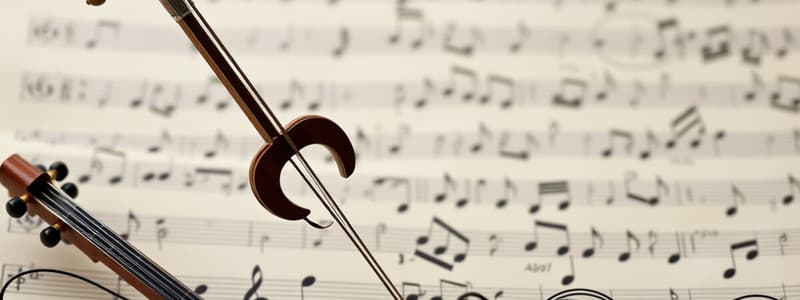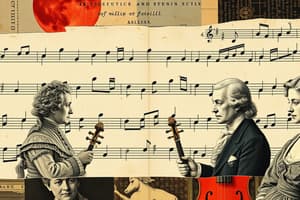Podcast
Questions and Answers
What are the dates of the Classical Period?
What are the dates of the Classical Period?
1750 to 1820
What was the Classical Era known as?
What was the Classical Era known as?
Age of Enlightenment
Why was the Classical Era known as the Age of Enlightenment?
Why was the Classical Era known as the Age of Enlightenment?
Reason was the best way to guide human conduct
List some political events that were happening during the Classical Era.
List some political events that were happening during the Classical Era.
Who had the power during the Classical Period?
Who had the power during the Classical Period?
What were Classical composers mostly interested in?
What were Classical composers mostly interested in?
What instrument replaced the harpsichord?
What instrument replaced the harpsichord?
Why did the piano replace the harpsichord?
Why did the piano replace the harpsichord?
Describe the orchestra of the Classical Period.
Describe the orchestra of the Classical Period.
List the instruments in the Classical string section of the orchestra.
List the instruments in the Classical string section of the orchestra.
List the instruments in the woodwinds section of the Classical orchestra.
List the instruments in the woodwinds section of the Classical orchestra.
List the instruments in the brass section of the Classical orchestra.
List the instruments in the brass section of the Classical orchestra.
List the instruments in the percussion section of the Classical orchestra.
List the instruments in the percussion section of the Classical orchestra.
Were trombones used in the Classical Orchestra?
Were trombones used in the Classical Orchestra?
List the four parts of the Sonata Form.
List the four parts of the Sonata Form.
Describe what happens in the exposition.
Describe what happens in the exposition.
Describe what happens in the development section of the sonata.
Describe what happens in the development section of the sonata.
Describe what happens in the recapitulation.
Describe what happens in the recapitulation.
Describe what happens in the coda in sonata form.
Describe what happens in the coda in sonata form.
What is a movement that is ABACABA?
What is a movement that is ABACABA?
What is a movement that is in ABA form and is often used as the third movement in symphonies?
What is a movement that is in ABA form and is often used as the third movement in symphonies?
What is a work for an instrumental soloist and orchestra called?
What is a work for an instrumental soloist and orchestra called?
What was the greatest contribution to instrumental music from the Classical Period?
What was the greatest contribution to instrumental music from the Classical Period?
Who was a pioneer in the development of the symphony and string quartet and wrote a concerto for the newly developed keyed trumpet?
Who was a pioneer in the development of the symphony and string quartet and wrote a concerto for the newly developed keyed trumpet?
Who was one of the most prolific composers that ever lived, and began as an amazing child prodigy?
Who was one of the most prolific composers that ever lived, and began as an amazing child prodigy?
When did Joseph Haydn live?
When did Joseph Haydn live?
When did Mozart live?
When did Mozart live?
When did Beethoven live?
When did Beethoven live?
Who was diagnosed with hearing loss at age 29 and became deaf by the end of his life?
Who was diagnosed with hearing loss at age 29 and became deaf by the end of his life?
Describe Joseph Haydn's life.
Describe Joseph Haydn's life.
Describe Mozart's life.
Describe Mozart's life.
Describe Beethoven's life.
Describe Beethoven's life.
Describe the difference in mood between Baroque and Classical music.
Describe the difference in mood between Baroque and Classical music.
Describe the difference in rhythm between Baroque and Classical music.
Describe the difference in rhythm between Baroque and Classical music.
Describe the difference in texture between Baroque and Classical music.
Describe the difference in texture between Baroque and Classical music.
Describe the difference in melody between Baroque and Classical music.
Describe the difference in melody between Baroque and Classical music.
Describe the difference in dynamics between Baroque and Classical music.
Describe the difference in dynamics between Baroque and Classical music.
A typical symphony has how many movements?
A typical symphony has how many movements?
List the type of movements that a typical symphony has.
List the type of movements that a typical symphony has.
Define theme and variations.
Define theme and variations.
List four of Mozart's most famous operas.
List four of Mozart's most famous operas.
What are some of Beethoven's most famous works?
What are some of Beethoven's most famous works?
Flashcards are hidden until you start studying
Study Notes
Classical Period Overview
- Dates: 1750 to 1820
- Also known as the Age of Enlightenment, emphasizing reason as a guide for human conduct.
Political Context
- Significant events: Seven Years' War, American Revolution, French Revolution, Napoleonic Wars.
- Power shifted to the middle class during this period.
Musical Characteristics
- Composers focused on balance and clarity in music.
- The piano replaced the harpsichord due to its ability to play dynamic variations.
Orchestra Structure
- The Classical orchestra was standardized into four sections: strings, woodwinds, brass, and percussion.
- String section included: 1st violins, 2nd violins, violas, cellos, double basses.
- Woodwinds comprised: 2 flutes, 2 oboes, 2 clarinets, 2 bassoons.
- Brass section had: 2 French horns, 2 trumpets.
- Percussion section featured: 2 timpani.
- Trombones were not commonly used, reserved for church and opera music.
Sonata Form
- Consists of four parts: exposition, development, recapitulation, and coda.
- Exposition: Introduction of themes in the tonic and new keys.
- Development: Varied treatment of themes.
- Recapitulation: Return to original themes and tonic key.
- Coda: Concludes the piece, remains in the tonic key.
Musical Forms
- Rondo Form: Structure can be described as ABACABA.
- Minuet and Trio: Follows ABA structure, often a symphonic third movement.
Instrumental Works
- A 'Classical concerto' features a soloist with orchestral accompaniment.
- The Classical symphony is regarded as the greatest contribution to instrumental music during this time.
Influential Composers
- Joseph Haydn: Known for developing the symphony and string quartet; lived from 1732 to 1809; composed 104 symphonies and numerous string quartets.
- Wolfgang Amadeus Mozart: Prolific composer; lived from 1756 to 1791; wrote operas such as The Marriage of Figaro and Don Giovanni. Renowned for versatility across genres.
- Ludwig Van Beethoven: Lived from 1770 to 1827; experienced deafness but composed nine symphonies and numerous piano sonatas despite his condition.
Life and Contributions of Composers
- Haydn was a servant to the Esterházy family and became wealthy after his London Symphonies.
- Mozart was a child prodigy, showcasing musical talent from an early age; his last work was a Requiem, completed while he was terminally ill.
- Beethoven's genius is marked by his early compositions and impact on subsequent music, including his famous piano sonatas.
Musical Differences: Baroque vs. Classical
- Mood: Baroque music had a single mood; Classical music featured multiple moods.
- Rhythm: Baroque music followed a strict rhythm; Classical music had a flexible approach.
- Texture: Classical music predominantly exhibited homophonic textures, contrasting with the polyphonic textures typical of Baroque music.
- Melody: Classical melodies were balanced and memorable, unlike the often complex melodies of the Baroque period.
- Dynamics: Classical music utilized crescendos and decrescendos, whereas Baroque music was characterized by terraced dynamics.
Symphony Structure
- A typical symphony consists of four movements: fast, slow, dance, and fast.
Musical Concepts
- Theme and Variations: A basic musical idea that is repeated with different arrangements.
Mozart's Notable Operas
- Famous operas include The Marriage of Figaro, Don Giovanni, The Magic Flute, and Cosi Fan Tutte.
Beethoven's Renowned Works
- Notable for his piano sonatas and his nine symphonies, which demonstrate his innovative contributions to music.
Studying That Suits You
Use AI to generate personalized quizzes and flashcards to suit your learning preferences.




